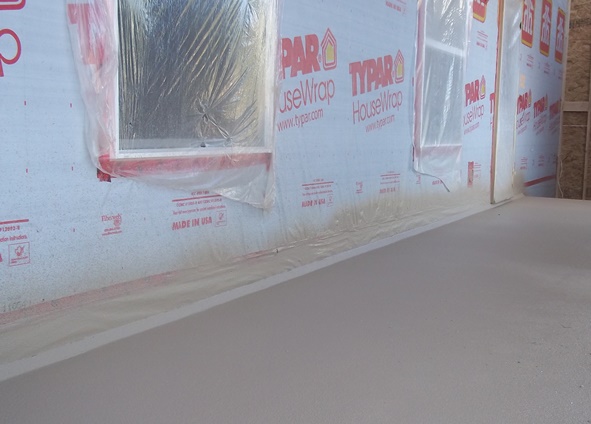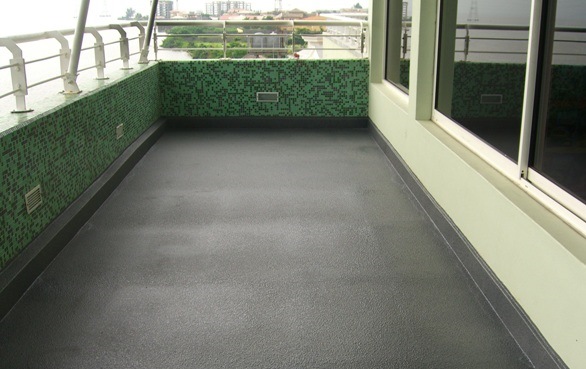Two-component polyurethane or polyurea spray coatings can eliminate many challenges associated with outdoor structures such as decks, patios, porches, and balconies. Despite their solid appearance, though, many of these substrates are porous and can deteriorate over time if not properly maintained or repaired. Even though polyurethane or polyurea coatings may add cost to an initial project estimate, these coatings can pay for themselves in no time based on their ability to prevent many issues otherwise associated with these types of outdoor structures.
The key to their effectiveness, however, is proper application. While these coating systems are becoming quite popular, quality application execution can make the difference in how effective the systems are and how long their protection lasts. Read on to learn a few of the common pitfalls in the application of deck and patio coatings — as well as strategies to avoid them.
Preparing for the Equipment
The first thing potential applicators should be aware of is the sheer volume of equipment involved.
“It’s not like I’m going to paint a deck, get a power washer, and then mop on some kind of deck material,” said Julie Short, marketing representative for polyurea and polyurethane spray-on protective coatings company ArmorThane. “This is a permanent solution. It takes an A and B side combination to make either the polyurethane or polyurea.”
Polyurethane is almost always used on decks, she explained, while polyurea is typically selected for sewage systems and water treatment systems that need stronger acid control.

Most deck applicators use an MCU trailer, otherwise known as a mobile coatings unit. These trailers contain the drums of product, as well as a compressor, generator, hose lines, proportioner, and more. The hose lines are typically extensive enough so that you can go around a house to get to the back, while the compressor and generator supply power for the operation.
“They bring their own electricity to the jobsite, basically,” Short said.
According to Short, owners at many smaller jobs often look at this process as something they can do themselves. But the complexity of the equipment makes that very difficult. “A lot of times, people will call and say ‘hey, if I could have some of that stuff, I just want to do my deck,’” she said. “But it takes a professional trained in chemical composition with equipment experience to do this kind of spraying. And it pays off in the long run because you don’t have that annual maintenance, peeling, chipping, and other problems.”
Spraying Tips
Even for trained sprayers, the process isn’t easy. With years of experience, ArmorThane has learned a handful of shortcuts and preventive steps by working with applicator dealers around the world.
For instance, wearing plastic booties over shoes are recommended to prevent adding dirt and debris when walking over a potentially tacky surface, according to ArmorThane’s Technical Director Rob Anderson. The group also advises using a leaf blower or dry compressed air during the spray process to keep the area clean. Utilizing two workers instead of one — a sprayer and someone else to move equipment and hoses out of the way to avoid dragging — can boost the quality and appearance of the final coating, Anderson said.
For the actual spraying process, the company asks applicators to make sure that everything is clean on spraying tips. “Otherwise if things start clogging up, it can give you an uneven spray pattern,” Short said. “When you’re spraying, especially on the final topcoat, you want to make sure you’re spraying in a consistent pattern because if you don’t, you can get some texturing that you may not want.”
Going into the project, owners should be aware of the type of finish they want. For instance, if the coating is being applied near a swimming pool, they may want more texture since the coating can be slippery if too smooth. On the other hand, if it’s just a regular patio, the owner may want a smoother coating, since texturing can make the surface more prone to collecting dirt.
“There are also different ways of texturing,” Short explained. “One is just by having a higher spray, which lets droplets fall and gives a smooth but textured surface. Whereas if you put some sort of aggregate down, it’ll be a heavier, rougher texture.”
Waterproofing, Weather Concerns
Owners must also consider potential issues related to climate. For example, if the project involves a patio connected to a house, waterproof barriers are essential. Otherwise, water and other liquids will eventually destroy the underlying structure.
The best approach is to seal the cracks, then spray at least part of the way up the vertical section, Anderson said. Different substrates may require different preparation and primer, since these coatings can be sprayed onto wood, concrete, or even brick and stone.
If connecting a wall to concrete, a chamfer molding can be used to connect the two right angle surfaces. The applicator would then spray the molding as well as the flat surface to keep water from seeping in between the patio and the structure, Anderson explained. Meanwhile, in the case of wood decking that butts against siding, a metal flashing should be applied to cover the crack, he said. Tape is then applied to seal the flashing to the wood before coating.
The climate during the application period is also a factor to consider. “While our systems can be applied in really cold or really warm weather, there are things that people need to watch out for,” Short said. “Particularly with moisture, it’s best to apply when humidity isn’t too high. We do certainly have rain, and we do have products that are used on projects with high moisture or are normally damp all the time, particularly in Southeast Asia. But those are not usually used on decks, especially in the U.S.”
Trust the Experts!
In addition to these tips, applicators should always follow standard curing times. For instance, new concrete must cure a minimum of 28 days before applying the sealer and topcoat. And when dealing with new treated lumber, applicators should wait between six to eight months to make sure that all of the oil seeps out. “Otherwise, it can de-bond the polyurethane,” Short said.
That advice may seem obvious to many professional coatings contractor, of course. But for owners of smaller assets, it’s the need to go through professionals that is most important to know.
“Above all else, people need to understand that this is not a do-it-yourself thing,” Short said. “You need to have knowledge and the right equipment to do this.”
This feature is part of a special anniversary series in 2017 in which CoatingsPro reflects on and updates the magazine’s most-read digital stories. To see the original article from October 2014, please click here. To read the other articles in the Greatest Hits series, click here
